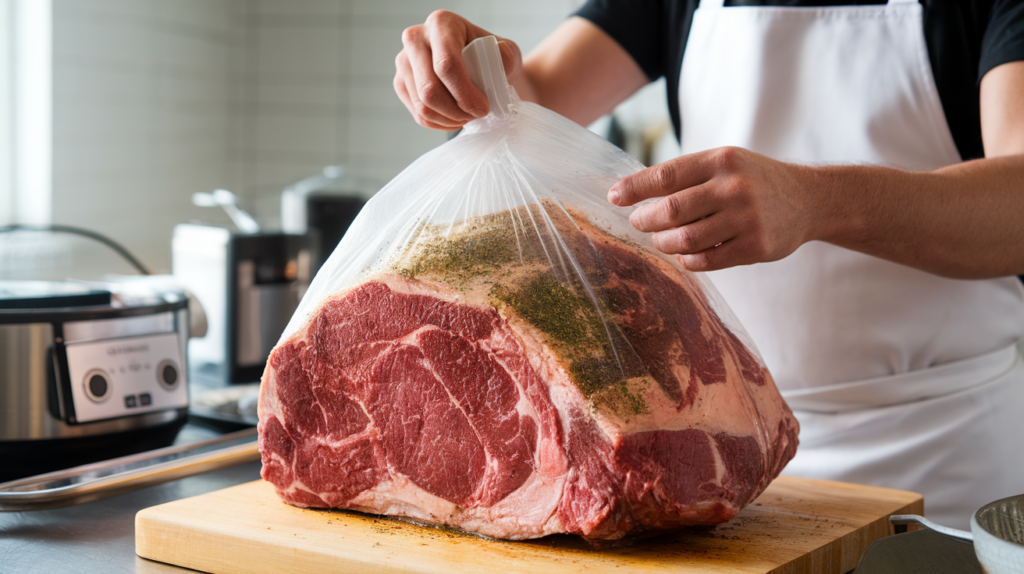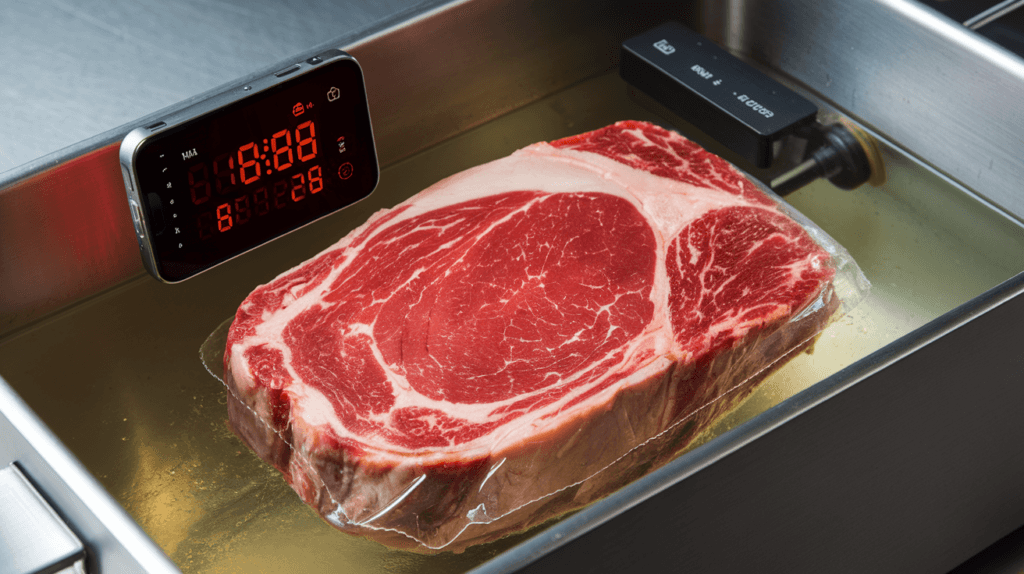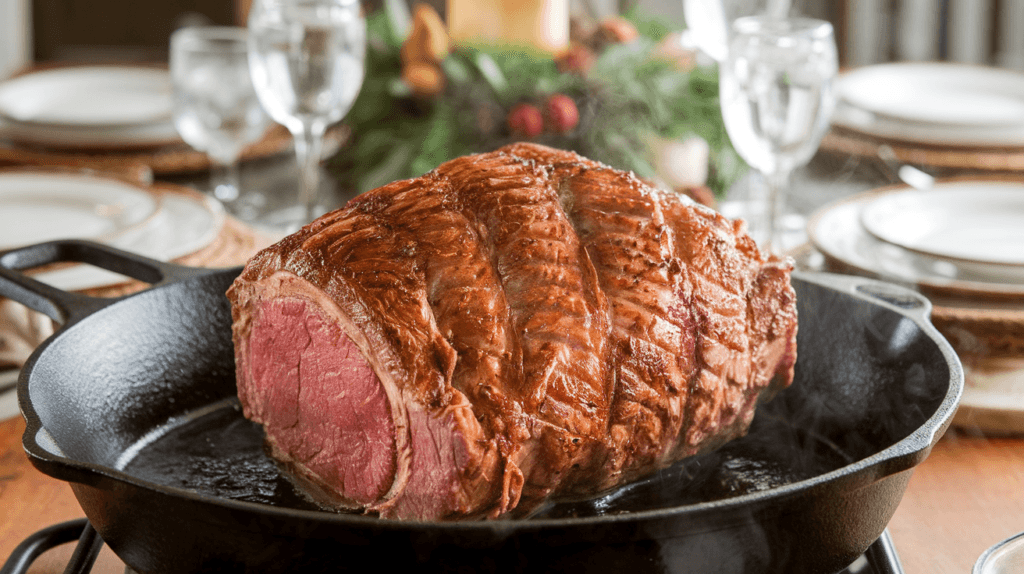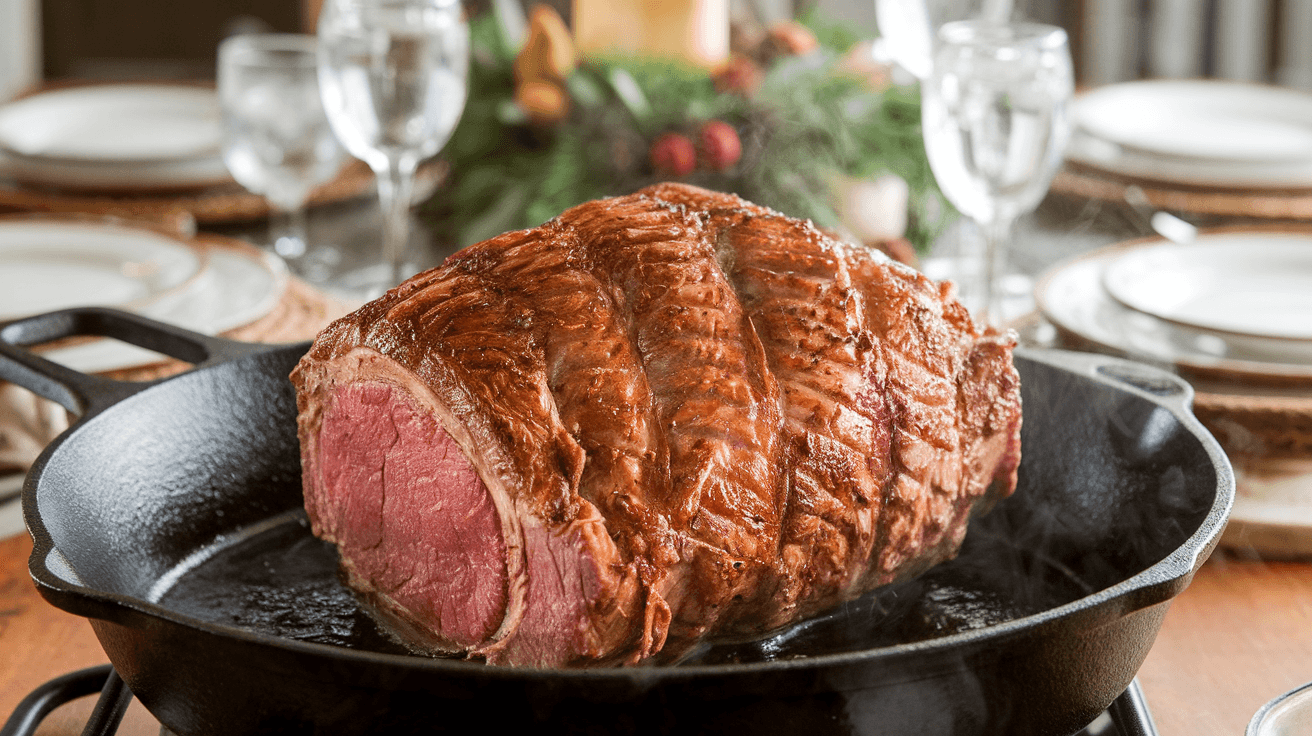Introduction
Sous vide cooking has revolutionized the way we prepare meat, offering unmatched precision and control. When it comes to prime rib, a centerpiece for any feast, timing is everything. This article will explore the ideal sous vide times for prime rib, ensuring a perfect cook every time.
From tender medium-rare slices to melt-in-your-mouth textures, sous vide allows home cooks to achieve restaurant-quality results. Let’s dive into the factors that determine the ideal time and temperature for sous vide prime rib and how to avoid common pitfalls.

What is Sous Vide Cooking?
Definition and Principles
Sous vide, which means “under vacuum” in French, is a cooking method that involves sealing food in a vacuum bag and cooking it in a water bath at a precisely controlled temperature. This method eliminates guesswork and ensures even cooking.
Benefits of Sous Vide for Prime Rib
Prime rib is a premium cut of beef, and sous vide ensures that it retains its natural juices and tenderness. With sous vide, you can:
- Avoid overcooking the outer layers while undercooking the center.
- Infuse flavors through marinades or rubs during the vacuum-sealing process.
- Achieve consistent results every time, regardless of the cook’s experience level.
Why Timing Matters for Sous Vide Prime Rib
Sous Vide Prime Rib: Texture and Doneness
Timing is critical when cooking prime rib sous vide because it directly affects the texture and doneness of the meat. Cooking for too short a time might not allow the collagen in the meat to break down, while overcooking can lead to a mushy texture. The beauty of sous vide is that it gives you a wider window to achieve perfection, but there are still optimal timing guidelines to follow.
Prime Rib Flavor Infusion with Extended Sous Vide Cooking
Another advantage of sous vide is the ability to enhance flavor by cooking for extended periods without compromising the quality of the meat. With proper timing, the prime rib absorbs marinades, spices, and seasonings, making each bite flavorful. However, extended times should be carefully managed to avoid altering the meat’s texture negatively.
How Long Should You Sous Vide a Prime Rib? Recommended Times
Medium Rare (Time and Temperature)
For a perfectly medium-rare prime rib, the recommended sous vide temperature is 132°F (55.5°C). Cooking time can range from 6 to 10 hours, depending on the thickness of the cut. This duration ensures the center is uniformly cooked, retaining a beautiful pink color.
Medium and Other Preferences
If you prefer your prime rib more done, you can increase the temperature and adjust the time accordingly:
- Medium: 135°F (57°C) for 6-10 hours.
- Medium-Well: 140°F (60°C) for 6-8 hours.
- Well Done: 145°F (62.8°C) for 6-8 hours.
These times and temperatures strike a balance between achieving your desired doneness and preserving tenderness.
Thickness Considerations
The thickness of the prime rib significantly impacts the cooking time. Thicker cuts, such as a 2-inch steak or a full roast, require the full 10 hours to ensure even cooking. Thinner cuts can be ready in as little as 6 hours. Always use a meat thermometer to double-check doneness before serving.
Why Timing Matters for Prime Rib
Texture and Doneness
The timing of sous vide cooking plays a crucial role in achieving the perfect texture and doneness for prime rib. A shorter cooking time may not allow the connective tissues to break down fully, while an excessively long time can alter the meat’s texture, making it mushy.
With sous vide, the doneness level is determined by temperature rather than time. However, time ensures the entire cut reaches an even temperature, resulting in a uniformly cooked piece of meat.
Flavor Infusion Through Extended Cooking
Sous vide cooking is not just about doneness—it’s also a method to enhance flavor. Extended cooking times allow marinades and seasonings to penetrate deeper into the meat, delivering a more robust taste. This process is particularly advantageous for large cuts like prime rib, where the center might otherwise lack seasoning.
Recommended Sous Vide Times for Prime Rib
Medium Rare (Time and Temp)
For a classic medium-rare prime rib, the recommended temperature is 131°F (55°C). The cooking time should be at least 6 hours but can extend up to 12 hours for enhanced tenderness. This range ensures the meat is tender and juicy without compromising texture.
Medium and Other Preferences
If you prefer your prime rib more cooked, adjust the temperature as follows:
- Medium: 135°F (57°C) for 6–10 hours.
- Medium Well: 145°F (63°C) for 6–8 hours.
- Well Done: 155°F (68°C) for 6–8 hours.
Note that higher temperatures can result in less juicy meat, so consider your preference carefully.
Thickness Considerations
Thickness plays a pivotal role in sous vide timing. A thicker cut requires more time to ensure even heating throughout. For example, a 2-inch-thick prime rib may need closer to the maximum recommended time, while a 1-inch-thick cut may suffice with the minimum time.
Factors Affecting Sous Vide Prime Rib Time
Thickness of the Prime Rib
The thickness of the prime rib directly influences the sous vide cooking time. A thicker cut takes longer for the heat to penetrate to the center, ensuring even doneness. For example:
- 1-inch thick: 6–8 hours for optimal tenderness.
- 2–3 inches thick: 8–12 hours for full cooking and texture improvement.
It’s important to measure the thickest part of the prime rib to calculate the cooking time effectively.
Bone-In vs. Boneless
Bone-in prime rib tends to cook slightly differently than boneless due to the bone acting as a heat conductor. While the cooking temperature remains the same, bone-in cuts may take longer to heat evenly, especially near the bone. Adjust your cooking time accordingly:
- Boneless: Follow standard cooking times based on thickness.
- Bone-In: Add an additional 1–2 hours to ensure even cooking.
Desired Doneness
Doneness preference dictates both the temperature and time. While the temperature determines the level of doneness (e.g., rare, medium-rare, or well-done), the cooking time ensures the meat reaches and maintains that temperature uniformly. For large cuts like prime rib, sticking to the minimum recommended times ensures safety and consistent results.
Step-by-Step Guide to How Long to Sous Vide a Prime Rib

Preparation Tips
Proper preparation is key to achieving perfect sous vide prime rib. Start by seasoning the meat generously with salt, pepper, and optional herbs or marinades. Vacuum-seal the meat in a bag to lock in the flavors and juices. If you don’t have a vacuum sealer, use the water displacement method with a resealable bag.
Setting the Time and Temperature
Using a precision cooker, set the water bath to your desired temperature based on your doneness preference:
- Rare: 125°F (52°C)
- Medium-Rare: 131°F (55°C)
- Medium: 135°F (57°C)
- Well-Done: 155°F (68°C)
Next, place the sealed prime rib in the water bath, ensuring it is fully submerged, and let it cook for the recommended time based on thickness and doneness.
Post-Sous Vide Searing
Once the sous vide process is complete, it’s time to sear the prime rib to develop a flavorful crust. Remove the meat from the bag, pat it dry with paper towels, and sear it in a hot cast-iron skillet with a high-smoke-point oil, such as avocado or canola oil. Sear for 1–2 minutes per side to achieve a golden-brown crust.
Common Mistakes to Avoid
Overcooking with Extended Time
While sous vide offers a flexible cooking method, extended times can affect the texture of the roast. Over time, the meat may become overly soft, losing its structure. Follow the suggested durations to achieve the perfect balance of tenderness and firmness.
Skipping the Searing Step
Searing is a vital step in the sous vide process that many home cooks overlook. Without a proper sear, your prime rib will lack the caramelized crust that enhances both flavor and presentation. Always dry the meat thoroughly before searing to ensure a beautiful, even crust.
Not Resting the Meat
Even with sous vide, it’s essential to let the meat rest for a few minutes after searing. Resting allows the juices to redistribute throughout the meat, ensuring each bite is as juicy as possible. Skipping this step can result in a less satisfying dining experience.
Sous Vide vs. Traditional Cooking for Prime Rib
Time Efficiency Comparison
Traditional cooking methods, such as roasting, can take hours and often require careful monitoring to avoid overcooking. Sous vide, on the other hand, provides a set-it-and-forget-it convenience. While the total time may be similar, the sous vide method eliminates guesswork, freeing up your time for other tasks.
Consistency in Results
One of the standout benefits of sous vide is its ability to deliver consistent results every time. Traditional methods often result in uneven cooking, with the outer layers overdone and the center undercooked. Sous vide ensures uniform doneness throughout the entire cut, making it ideal for prime rib.
Enhanced Flavor and Texture
In traditional cooking, juices tend to escape, leaving the meat drier. Cooking with sous vide retains the natural moisture, making the roast more tender and flavorful. Additionally, longer cooking times enhance the infusion of flavors, especially when using marinades or spice blends.
Frequently Asked Questions (FAQs)
What is the minimum sous vide time for prime rib?
The minimum sous vide time for prime rib is around 6 hours. This allows the meat to reach an even temperature throughout and ensures the desired doneness is achieved. However, extending the time up to 12 hours can enhance tenderness without compromising quality.
Can I sous vide prime rib overnight?
Yes, sous vide cooking overnight is a common practice. For prime rib, cooking it for 8–12 hours at the desired temperature is safe and effective. This method is especially convenient when preparing for large gatherings, as it allows you to focus on other preparations during the day.
What temperature is best for medium-rare prime rib?
The ideal temperature for medium-rare prime rib is 131°F (55°C). This temperature ensures the meat is perfectly pink and tender while retaining its natural juices. Be sure to maintain this temperature throughout the cooking process for consistent results.
Do I need a vacuum sealer for sous vide prime rib?
While a vacuum sealer is the best option for sous vide cooking, you can use the water displacement method with resealable freezer bags. This technique involves partially sealing the bag and submerging it in water to remove air before sealing completely.
Should I season the prime rib before sous vide?
Yes, it’s best to season your roast before cooking it sous vide. Use a generous amount of salt, pepper, and optional herbs or spices. This preparation step enhances flavor as the seasoning deeply infuses into the meat during the extended cooking time.
Can I sous vide a frozen prime rib?
Absolutely! Sous vide is an excellent method for cooking frozen meats. Simply add an additional 1–2 hours to the cooking time to account for the frozen state. Ensure the temperature remains consistent to achieve the desired doneness.
Conclusion
Sous vide cooking offers an unparalleled level of control and precision, making it the perfect method for preparing prime rib. By understanding the factors that affect sous vide time—such as thickness, bone-in vs. boneless, and desired doneness—you can consistently achieve restaurant-quality results at home.

For medium-rare prime rib, the sweet spot is 131°F (55°C) for 6–12 hours, but the flexibility of sous vide allows you to experiment and tailor the process to your preferences. Don’t forget the essential final steps of searing and resting to elevate your prime rib to its full potential.
Whether hosting a festive dinner or enjoying a family meal, sous vide guarantees your roast is tender, flavorful, and cooked to perfection. Now that you understand the ideal timing for this method, it’s time to put your skills to work and wow your guests!

